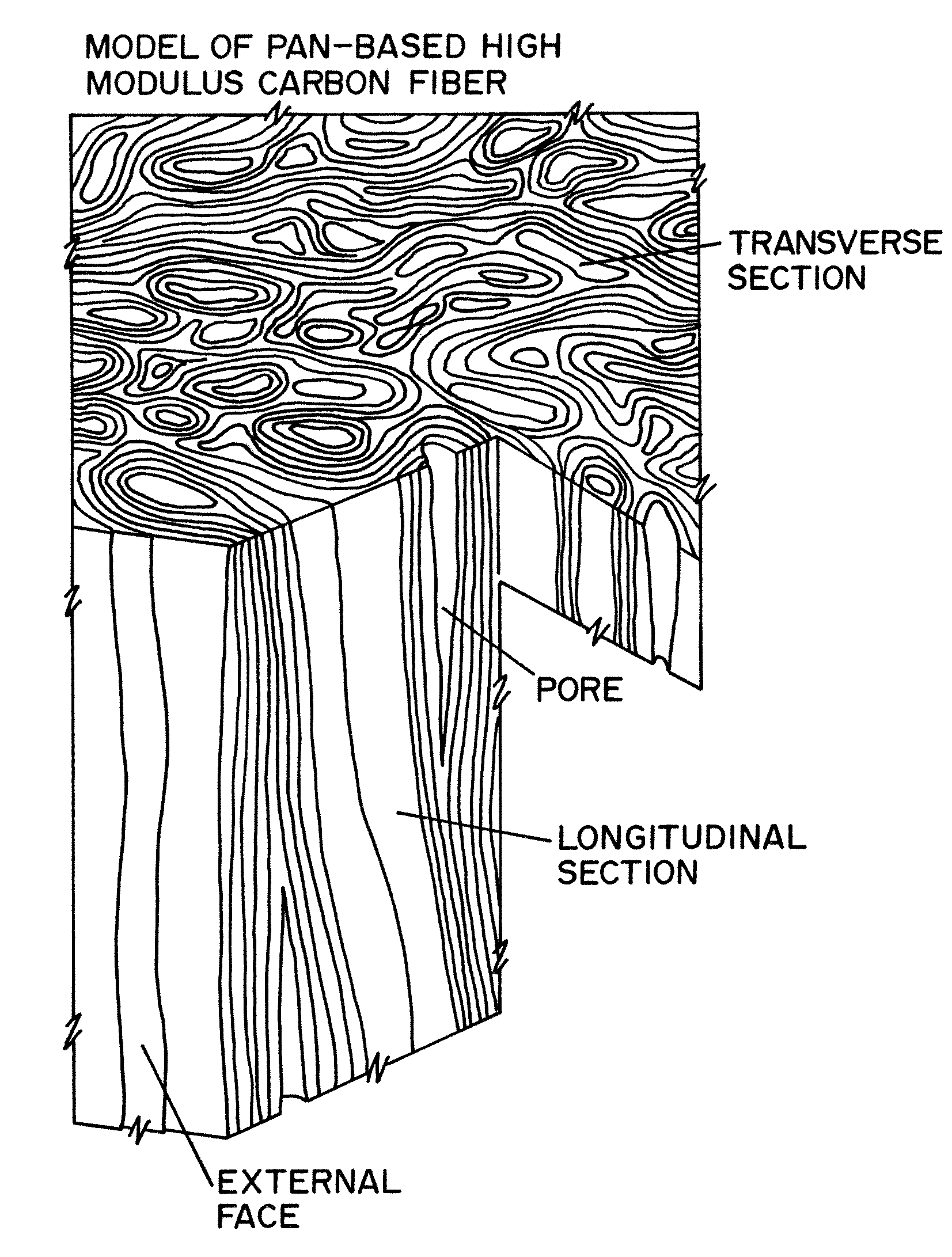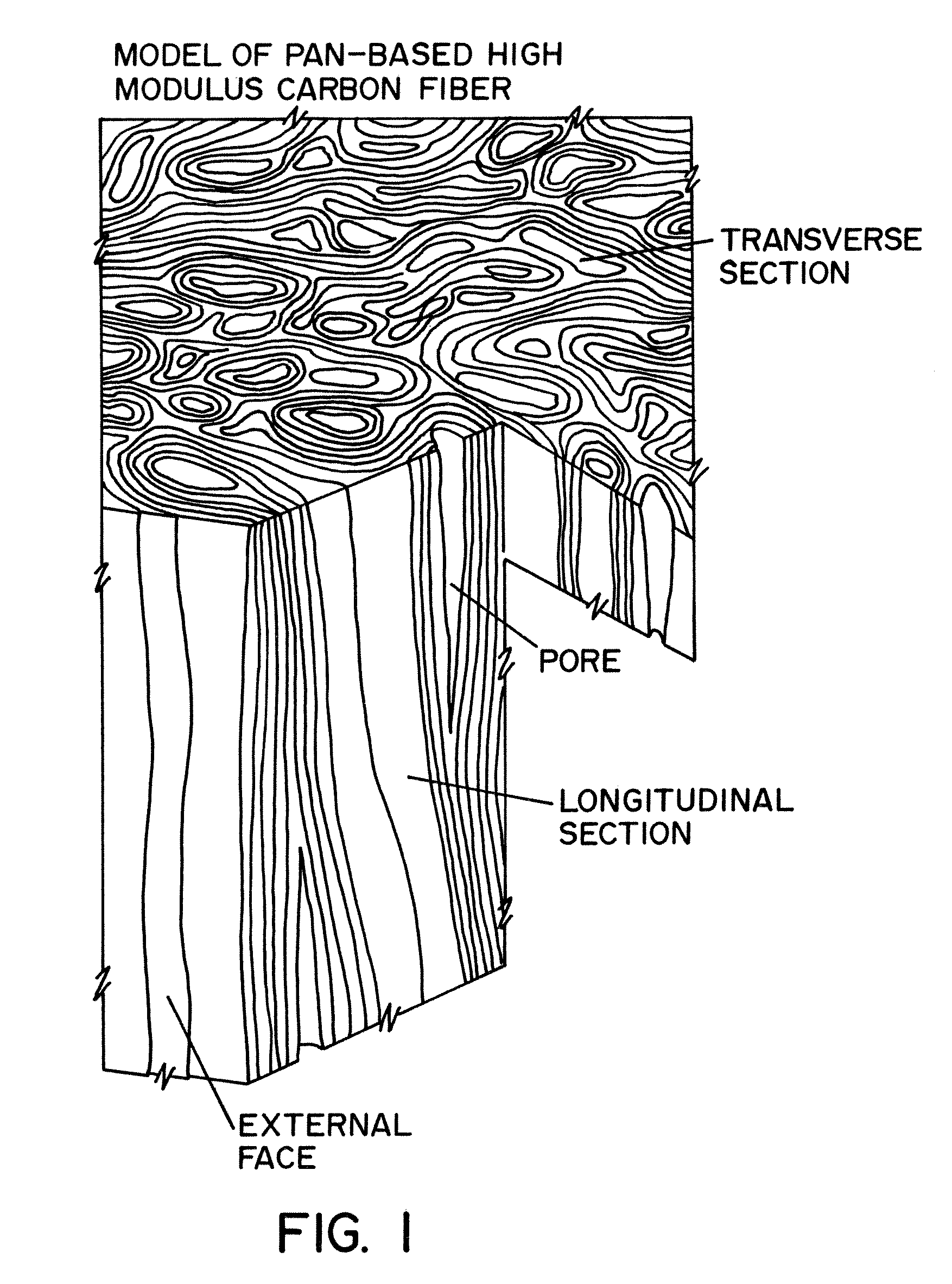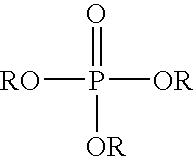Multipurpose resin composition and process for manufacturing the same
Inactive Publication Date: 2008-11-13
GARLAND INDS
View PDF13 Cites 1 Cited by
- Summary
- Abstract
- Description
- Claims
- Application Information
AI Technical Summary
Benefits of technology
[0008]The use of strong oxidizers on the surface of carbon fiber can enhance the ability of the carbon fibers to adhere to certain types of resin matrices. The oxidized state of the fiber surface, once generated, typically needs to be preserved to achieve the desired bond of the resin matrices to the carbon fibers, since it is believed that the oxidized state of the carbon fiber surface is unstable. It is believed that oxygen complexing with the carbon surface of the carbon fibers is the means by which enhanced adhesion results between the carbon fibers and resin matrices.
[0010]Manufacturers of advanced, high strength carbon fiber types (e.g., T300, T500, T700, etc.) can control the carbonization process to obtain stronger carbon fibers. It is known that the strength of T300 fibers increases from 2.2 to 3.2 Gpa after heat treatment to 2800° F. Such heat treatment under tension increases carbon cyclization and eliminates nitrogen from the carbon fiber. As such, this carbonization process produces a more perfect cyclized structure that is absent nitrogen to a greater extent than other commercially available carbon fibers. This more perfect cyclized structure for the carbon fiber is one reason why this type of fiber surface becomes difficult to adhere to. Another reason for difficult adhesion is from the use of vinyl ester polymer (VEP) (cross linked in the application process) as a sizing. Development of good adhesion to such surfaces often requires two mechanisms. The first mechanism is the solvation ofthe vinyl ester surface and the co-mingling of molecules at that location with the bonding resin. In this first mechanism, the styrene monomer in the bonding resin softens and partially dissolves the surface of the sizing. Molecules from the bonding resin co-mingle with those on the solvated sizing surface and re-cure with the cure of the bonding resin locking them together. These processes provide a mechanical lock of the two polymers at the molecular level. The second mechanism is the actual cross linking between the bonding resin and any unreacted double bonds on the vinyl ester sizing surface. Highly efficient application of vinyl ester sizing results in a high rate of conversion (cross linking) during cure in the sizing leaving few, if any, reactive sites for secondary cross linking. In addition, the resulting cured sizing is highly chemical resistant, thereby reducing its tendency to be solvated by the bonding resins (other polyesters and vinyl esters).
[0012]The surface of carbon fibers is a fairly imperfect structure. Because of the “tug of war” that exists in the processing variables of carbonization, imperfect cyclized structures result on the carbon fibers. The microtexture of the carbon fiber surface depends on a variety of variables affecting carbonization. There are trade offs between carbon fiber tensile strength and stiffness properties. The production of higher modulus carbon fibers requires higher heat treatment temperatures. Higher modulii results because the carbon fiber becomes more compact and the void spaces within the carbon fiber are smaller. The higher heat treatment temperatures for the carbon fibers promote the joining of oriented and touching layers of the carbon fibers, thus improving parallel alignment and compaction of the carbon in the carbon fibers. The carbon fiber surface comprises layers, folds and pores as illustrated in FIG. 1. Better carbon fiber properties have a reduced number of folds, pores and voids. However, such carbon fibers have a reduced amount of defect planes wherein oxygen complexing can occur.
[0022]In another andi / or alternative non-limiting aspect of the present invention, the activated PE molecule can promote a much higher degree of adhesion between unsaturated polyesters (e.g., vinyl ester and / or polyester matrices that are based on orthophthallic, isophthallic and terephthalic acids, etc.) and a broad variety of substrates including aramid fibers, aluminum, stainless steel, secondarily bonded composite surfaces, damp composite surfaces, stone, cement and a wide variety of masonry products.
[0023]It is one non-limiting object of the present invention to provide a multipurpose / process resin composition that has improved adhesion to fibers such as, but not limited to, carbon fibers and aramid fibers.
[0024]It is another andi / or alternative non-limiting object of the present invention to provide a multipurpose / process resin composition that has good adhesion to aluminum, stainless steel, secondarily bonded composite surfaces, damp composite surfaces, stone, cement and a wide variety of masonry products.
Problems solved by technology
The oxidized state of the fiber surface, once generated, typically needs to be preserved to achieve the desired bond of the resin matrices to the carbon fibers, since it is believed that the oxidized state of the carbon fiber surface is unstable.
This more perfect cyclized structure for the carbon fiber is one reason why this type of fiber surface becomes difficult to adhere to.
Method used
the structure of the environmentally friendly knitted fabric provided by the present invention; figure 2 Flow chart of the yarn wrapping machine for environmentally friendly knitted fabrics and storage devices; image 3 Is the parameter map of the yarn covering machine
View moreImage
Smart Image Click on the blue labels to locate them in the text.
Smart ImageViewing Examples
Examples
Experimental program
Comparison scheme
Effect test
example 1
[0035]
Unsaturated Polyester Resin 40-99.9%Phosphate and / or Phosphite Ester0.1-60%Curing Agent or Catalyst0.01-20%
example 2
[0036]
Unsaturated Polyester Resin60-99%Phosphate and / or Phosphite Ester0.5-40% Curing Agent or Catalyst0.01-15%
example 3
[0037]
Unsaturated Polyester Resin60-99%Phosphate and / or Phosphite Ester 1-40%Acrylate and / or Methacrylate0.1-40% Monomer and / or CompoundCuring Agent and / or Catalyst0.01-15%
the structure of the environmentally friendly knitted fabric provided by the present invention; figure 2 Flow chart of the yarn wrapping machine for environmentally friendly knitted fabrics and storage devices; image 3 Is the parameter map of the yarn covering machine
Login to View More PUM
| Property | Measurement | Unit |
|---|---|---|
| Fraction | aaaaa | aaaaa |
| Percent by mass | aaaaa | aaaaa |
| Percent by mass | aaaaa | aaaaa |
Login to View More
Abstract
A multipurpose process resin formulation which produces superior adhesion on a variety of different substrates including, but not limited to, carbon and aramid fibers. The resin formulation includes a mixture of a thermosetting polyester and or vinyl ester resin; a polymerizable and,or non-polymerizable phosphate ester phosphite ester and / or oligomer; and a curing and or catalyzing agent. The resin formulation can include an alkyl acrylate and / or methacrylate monomer and / or compound.
Description
[0001]The present invention claims priority on U.S. Provisional Patent Application Ser. No. 60 / 917,127 filed May 10, 2007 entitled “Multipurpose Resin Composition and Process for Manufacturing the Same”, which is fully incorporated by reference herein.[0002]The present invention relates to resin compositions, particularly to resin compositions that include thermosetting polyester and / or vinyl ester resins, phosphate and / ,or phosphite ester compounds, more particularly to resin compositions that include unsaturated thermosetting polyester and / or vinyl ester resins, phosphate and / or phosphite ester compounds, and even more particularly to resin compositions that include unsaturated thermosetting polyester and / or vinyl ester resins, phosphate and / or phosphite ester compounds, and alkyl acrylate and / or methacrylate monomers.BACKGROUND OF THE INVENTION[0003]Present day commercially available carbon fibers are supplied with two general types of sizing. First there are those based on vinyl...
Claims
the structure of the environmentally friendly knitted fabric provided by the present invention; figure 2 Flow chart of the yarn wrapping machine for environmentally friendly knitted fabrics and storage devices; image 3 Is the parameter map of the yarn covering machine
Login to View More Application Information
Patent Timeline
 Login to View More
Login to View More IPC IPC(8): C08G63/91C08L67/02
CPCC08K3/22C08K5/51C08L67/06
Inventor STRAND, RICHARD M.
Owner GARLAND INDS
Features
- R&D
- Intellectual Property
- Life Sciences
- Materials
- Tech Scout
Why Patsnap Eureka
- Unparalleled Data Quality
- Higher Quality Content
- 60% Fewer Hallucinations
Social media
Patsnap Eureka Blog
Learn More Browse by: Latest US Patents, China's latest patents, Technical Efficacy Thesaurus, Application Domain, Technology Topic, Popular Technical Reports.
© 2025 PatSnap. All rights reserved.Legal|Privacy policy|Modern Slavery Act Transparency Statement|Sitemap|About US| Contact US: help@patsnap.com



